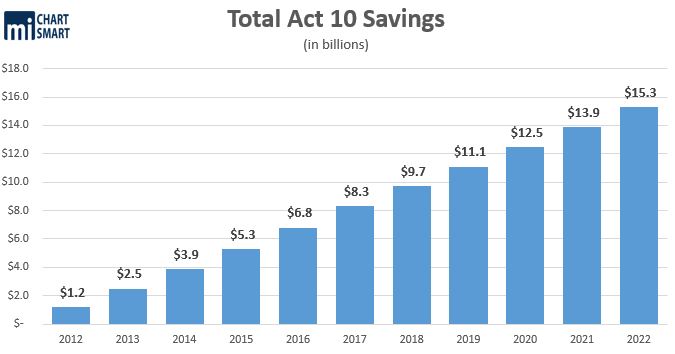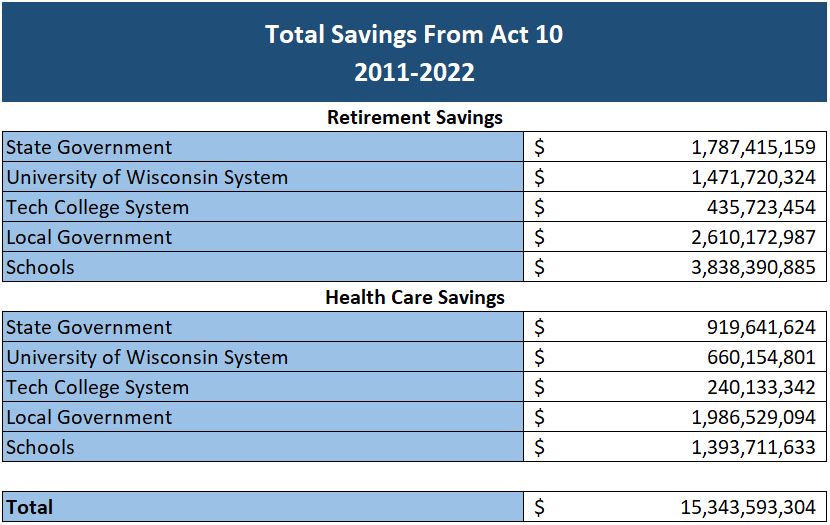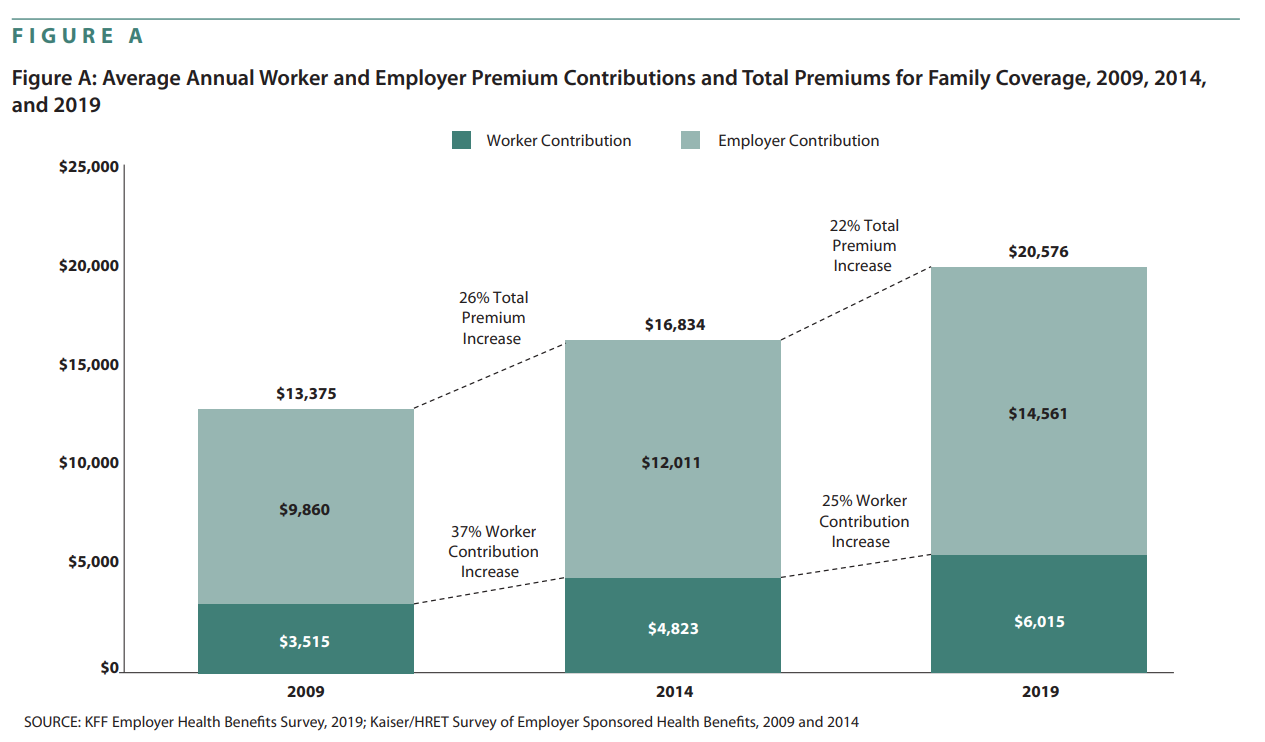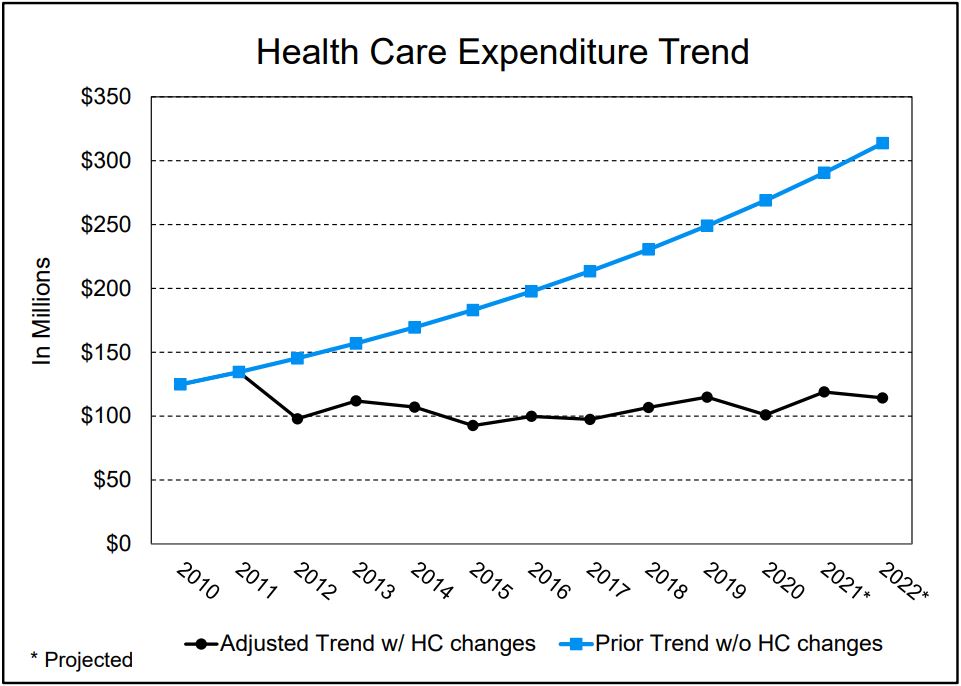
Even after Act 10, state employees still pay roughly half for their platinum health insurance of what taxpayers pay for basic health insurance in the real world
The Baraboo School District recently used the Act 10 freedoms to save $1 million dollars on health insurance in ONE year
MacIver News Service | Mar. 11, 2022
It’s been 11 years since Wisconsin Republicans led by Gov. Scott Walker passed collective bargaining reform, and the savings to taxpayers have been piling up ever since.
Known as Act 10, the reforms were designed to permanently solve a financial crisis throughout Wisconsin’s public sector. State government alone was facing a $3.6 billion deficit in its next budget. The situation was even worse for local governments (including school districts). Act 10 required all public employees to begin making contributions towards their own health insurance and pensions.
Using the same methodology that we have always used and the same public data sources, we estimate Act 10 has saved Wisconsin taxpayers at least $15.3 billion statewide at the state and local level since 2011.

We calculated the savings achieved from the pension and health insurance changes using the state Comprehensive Annual Financial Report and local sources. That includes $10.1 billion just from public employees making contributions to their own pensions. The MacIver Institute included contribution amounts from employees in state agencies, the UW system, public authorities, municipalities, towns, counties, school districts, tech colleges and CESAs. Prior to Act 10, most of them weren’t required to contribute anything towards their pension, and taxpayers paid both the employer contribution and the employee contribution towards retirement. Now most government employees in Wisconsin are responsible for half of the contribution to their own pension fund and taxpayers pick up just the other half.
In addition to finally requiring government employees to pay something towards their pension, Act 10 also required public employees to pay 12.6% of their health insurance premiums. Our new analysis shows that local governments have saved $2.22 billion, the state and university system have saved $1.57 billion, and school districts have saved $1.39 billion over the past eleven years on health insurance.
The state of Wisconsin is now required by law to track school district benefit savings. The most recent data available from the state is through 2020. The savings at that time was $1.4 billion. State agency and UW system health care savings were calculated using the Department of Administration’s six-year averages, which come out to $1.3 billion.
Before the unions convince you that contributing 12.6% towards health insurance is an unfair and undue burden, think about this. A state employee in Wisconsin pays $2,952 a year for the regular family plan with dental. According to the Kaiser Family Foundation, the average annual worker premium contribution is $6,015 a year. State employees pay roughly half of what the average taxpayer pays for health insurance and the state employee is receiving platinum coverage for that reasonable amount.

Act 10 also limited what public-sector unions could negotiate for. These changes were meant to give state and local governments more flexibility to identify potential savings and keep their budgets balanced. It had an immediate impact.
According to the City of Milwaukee, “Prior to 2012, total health care expenditures were increasing at a rate of 8% to 9% annually, reaching almost $139 million in 2011 and were projected to reach $187 million by 2015. In light of this unsustainable trend, the city with the support of policymakers, elected officials, employees, and vendor partners took steps to control the rising costs of health care, encourage better utilization by members, increase employee engagement through a formalized wellness program, and minimize and prevent workplace injuries.”

Tracking health insurance savings throughout the state is more complicated. There are thousands of local units of government and some Act 10 savings at the local level go unnoticed and unpublicized. Act 10 permanently changed the trajectory of those local healthcare costs. Local governments like the City and County of Milwaukee include that information in their annual budgets – and the savings continue to grow exponentially. The most recent estimate showed $667.5 million in savings. Think of where the city of Milwaukee and Milwaukee County would be if they did not have Act 10 to effectively manage their costs.
Even more than ten years on, local governments are still reaping significant taxpayer savings using Act 10. Just last year, after switching health insurance plans thanks to the management freedom from Act 10 to make such decisions, the Baraboo School District reported that it saved $1 million in just one year. When the school district decided to make the switch back in 2019, it was hoping to save approximately $430,000 a year. The switch in health care plans saved the district an astonishing 20%. Unfortunately, with a mainstream media asleep at the switch or deliberately ignoring it because it has to do with Act 10, Baraboo’s success has gone largely unnoticed and certainly has not been celebrated statewide like it should be.
Baraboo’s experience is an example of why the $15.3 billion in total Act 10 savings since 2011 is conservative or on the low side. No one is able to track the exact and continuing savings for each of the 1,900 or so units of government in Wisconsin.
Ultimately, Act 10 finally put the State of Wisconsin, local governments and school districts back on a solid financial footing. More importantly, Act 10 ultimately put Wisconsin taxpayers back in charge of our government and back in control of our future.